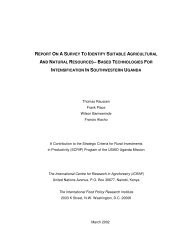Continuities in environmental narratives, Kabale, Uganda ... - Foodnet
Continuities in environmental narratives, Kabale, Uganda ... - Foodnet
Continuities in environmental narratives, Kabale, Uganda ... - Foodnet
Create successful ePaper yourself
Turn your PDF publications into a flip-book with our unique Google optimized e-Paper software.
Thus a number of policies (soil conservation, resettlement, swamp reclamation and land<br />
consolidation) developed out of colonial concerns about the threats of overpopulation and<br />
associated <strong>environmental</strong> degradation, and were implemented with vary<strong>in</strong>g degrees of success. The<br />
<strong>environmental</strong> <strong>narratives</strong> that drove these policies carry with them an assumption that <strong>in</strong>digenous<br />
methods of cultivation were <strong>in</strong>adequate to cope with change and pressure on resources. With only<br />
one or two exceptions there was little recognition or credit given to the ability of the agricultural<br />
system, and the people with<strong>in</strong> it, to ma<strong>in</strong>ta<strong>in</strong> the natural resource base. As Hoben has argued <strong>in</strong> the<br />
case of Ethiopia ‘the neo-Malthusian narrative’s denigration of <strong>in</strong>digenous agriculture has led<br />
experts and planners to overlook and filter out much <strong>in</strong>formation about the strengths of<br />
<strong>in</strong>digenous resource management practices.’ 48 This is perhaps unsurpris<strong>in</strong>g given the context of<br />
the colonial system, and assumptions of ‘primitive’ agricultural systems. But how did this<br />
change with the com<strong>in</strong>g of Independence?<br />
Post colonial <strong>narratives</strong> and policy rhetoric<br />
The reputation that Kigezi ga<strong>in</strong>ed <strong>in</strong> the colonial period is one that it has never been able to<br />
shake off. Rather, it has been cont<strong>in</strong>ually reiterated and elaborated upon and the <strong>environmental</strong><br />
degradation narrative rema<strong>in</strong>s little changed. It is strik<strong>in</strong>g how little the claims made about the<br />
district have changed over the past decades: statements made about Kigezi’s problems today<br />
could be almost verbatim quotes from colonial reports written 50 or 60 years earlier. In recent<br />
years the familiar fears about over-population and soil erosion have been summed up by the<br />
phrase ‘<strong>environmental</strong> susta<strong>in</strong>ability’. But the assumptions and fears beh<strong>in</strong>d this phrase, and the<br />
language used to convey these, have changed very little, as the follow<strong>in</strong>g section will show.<br />
In the immediate post-Independence period <strong>in</strong>fluential writers such as Allan commented<br />
on the ‘very serious congestion’ <strong>in</strong> <strong>Kabale</strong>, observ<strong>in</strong>g how ‘all the usual symptoms of overpopulation’<br />
were evident, <strong>in</strong>clud<strong>in</strong>g ‘almost cont<strong>in</strong>uous cultivation and consequent soil degradation,<br />
subdivision and excessive fragmentation of land.’ 49 Studies conducted by Makerere University staff<br />
cont<strong>in</strong>ually re-iterated the familiar concerns. Kagambirwe observed that the soil <strong>in</strong> the area had<br />
deteriorated referr<strong>in</strong>g to ‘an assumption that there is considerable population pressure on the<br />
land.’ 50 Without question<strong>in</strong>g this assumption he refers to ‘the cry for land for cultivation’ and the<br />
‘exhausted’ hillslopes, thus adopt<strong>in</strong>g the same <strong>environmental</strong> degradation narrative. Other<br />
Makerere studies conducted <strong>in</strong> the 1970s <strong>in</strong>clude that by Langlands, who notes that population<br />
pressure <strong>in</strong> some parts of the district was such that ‘it is improbable that further <strong>in</strong>creases could<br />
take place under exist<strong>in</strong>g technological practices.’ 51 Kateete observes that fallow<strong>in</strong>g was limited<br />
due to too much pressure on land, 52 and there are a number of studies concerned with the<br />
problems associated with fragmentation of land. 53<br />
48<br />
Hoben ‘The cultural construction of <strong>environmental</strong> policy’, 201.<br />
49<br />
W. Allan, The African Husbandman, (Ed<strong>in</strong>burgh, 1965).<br />
50<br />
Kagambirwe, E.R., ‘Causes and consequences of land shortage <strong>in</strong> Kigezi’ (Makerere, Department of Geography,<br />
Occasional Paper 23, 1973), 69 and 76.<br />
51<br />
Langlands, B.W., ‘A population geography of Kigezi District’ (Makerere, Department of Geography, Occasional<br />
Paper 26, 1971).<br />
52<br />
B.M. Kateete, , ‘Land tenure and land use <strong>in</strong> Humurwa parish, Ikumba sub-county, Rubanda County, Kigezi<br />
District’ <strong>in</strong> R. T<strong>in</strong>dituuza and B.M. Kateete, ‘Essays on land fragmentation <strong>in</strong> Kigezi District’ (Makerere,<br />
Department of Geography, Occasional Paper 22, 1971).<br />
53<br />
Such as A.R. Kururagire, ‘Land fragmentation <strong>in</strong> Rugarama, Kigezi’, <strong>Uganda</strong> Journal, 33 (1969), 59-64.<br />
D:\_<strong>Uganda</strong> Land Use\SW land use and soils\Carswell papers\Carswell- Narratives paper-17 Dec.doc<br />
9
















